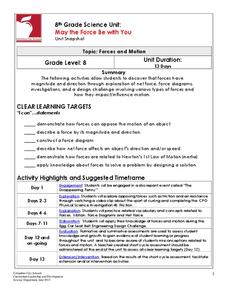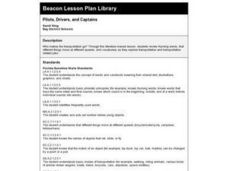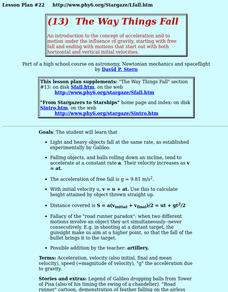Columbus City Schools
May the Force Be with You
You won't have to force your classes to complete these engaging activities! Through exploration, young scientists learn that force has both magnitude and direction. They draw force diagrams, investigate force models, and complete a...
American Chemical Society
Does Temperature Affect Dissolving?
When making sweet tea, why do people dissolve the sugar in hot tea instead of cold tea? The class discusses the previous lab and builds upon it. Working in groups, they design an experiment to determine how temperature affects the...
Curated OER
Swinging Pendulum
Middle schoolers engage in an activity which demonstrates how potential energy (PE) can be converted to kinetic energy (KE) and back again. Given a pendulum height, students calculate and predict how fast the pendulum will swing by...
Curated OER
Hurricanes 2: Tracking Hurricanes
Students examine the role of technology in identifying and tracking hurricanes.
Curated OER
Gravity Launch
Pupils use an online interactive to launch a rocket from earth. They have control over the angle and thrust of the rocket to discover the relationship between the two.
Curated OER
Water and Ice
Young scholars will work in small groups, observing an ice cube and recording a description, the feel of the ice, and how it looks when put in another container. Students observe changes in the ice over 15 minute intervals, then freeze...
Curated OER
Construction and Use of an Accelerometer
Eighth graders, in groups, study acceleration and build an accelerometer.
Curated OER
Pilots, Drivers, and Captains
Students listen to the song, The Wheels on the Bus, then change the words for a boat.
Curated OER
Weightlessness
Students predict the behavior of coffee in a cup while it is dropped during a demonstration. They relate their observations to the weightless conditions that astronauts experience in space and discuss the concept of free-fall.
Curated OER
Flying Tube
Students investigate how a spinning paper tube generates lift as it travels forward.
Curated OER
Colored Clouds
Fourth graders, in groups, examine how particles in warm water move faster than particles in cold water.
Curated OER
Simple Machines or Are They?
Students discover basic machines and how they make completing work easier. They identify two basic machines, the inclined plane and the lever and the functions of these simple machines.
Curated OER
What is Temperature?
Students examine how temperature is the measure of the average kinetic energy of the molecules of a substance.
Curated OER
Olympic Training Center
Students decide on an activity like running, swimming or skating for a performance analysis. They have friends or family members videotape them as they exercise, then review the video to see how they can improve their performance.
Curated OER
Building Bridges
Students identify the different types of bridges. Using the internet, they research information on how they are built by completing a scavenger hunt. Locating a specific area, they determine which type of bridge would be appropriate and...
Alabama Learning Exchange
Energy and Work Amusement Park Style
Students distinguish between kinetic and potential energy. They recognize that energy can change from one form to other forms. They identify and describe several forms of energy.
Curated OER
Friction Flyers
Students explore the principles of magnetism and friction. They complete an interactive puzzle on the Gizmos and Gadgets computer software, construct a vehicle, build and modify ramps and vehicles to produce various outcomes, and...
Curated OER
Sucking Students into an Understanding of Air Pressure and Vacuums
Students develop and test their ideas about air pressure and vacuums by conducting several investigations into the movement of fluids in tubes.
Curated OER
Solar Racing
High schoolers harness the power of the sun to design, construct and evaluate a solar-powered model car of their creation. They race their cars in a "Solar Sprint" race modeled after the National Renewable Energy Laboratory's Junior...
Curated OER
Galileo: His Times & Beliefs
Students study Galileo and his scientific discoveries. They complete a series of experiments/model constructions, using 17th century equipment and procedures, to "recreate," demonstrate and explore the various discoveries of Galileo.
Curated OER
Matter for Minors
Students use streaming videos, web sites, and hands on activities students to explore matter. They focus on how temperature affects matter and what the particles look like in the states of matter.
Curated OER
Physics: Vector Addition
Students drill and practice putting problems into vector form. They draw each problem before trying to solve them. Students draw arrows for any vector quantities to indicate magnitude and direction.
Curated OER
Catapults!
Students work together to discover the relationship between the angle of catapults and the flight of different objects. They discover the heavier the object the more force is needed. They examine how engineers use this information to...
Curated OER
The Way Things Fall
Pupils see that light and heavy objects fall at the same rate, as established experimentally by Galileo. They see that falling objects, and balls rolling down an incline, tend to accelerate at a constant rate a. Their velocity increases...
























